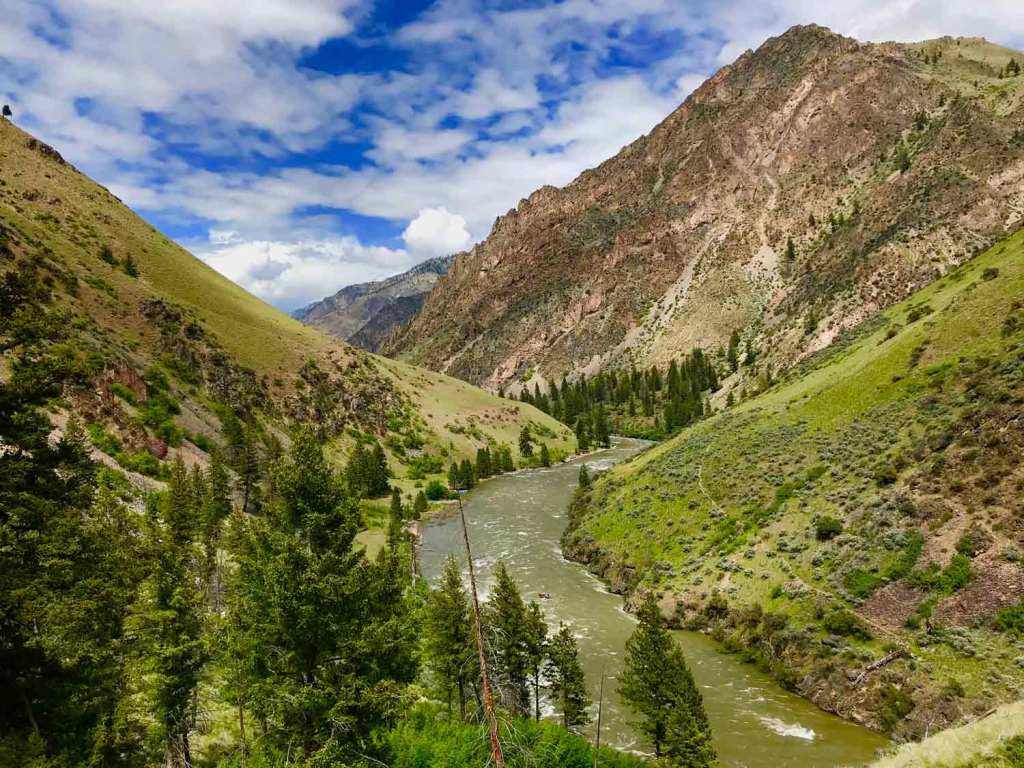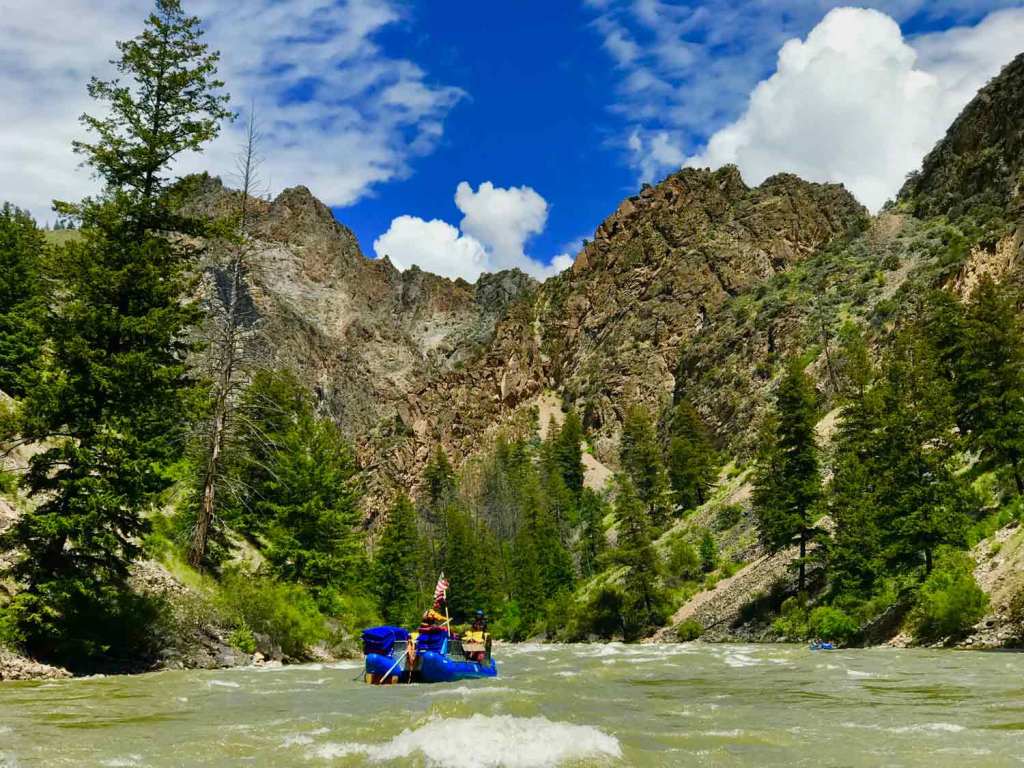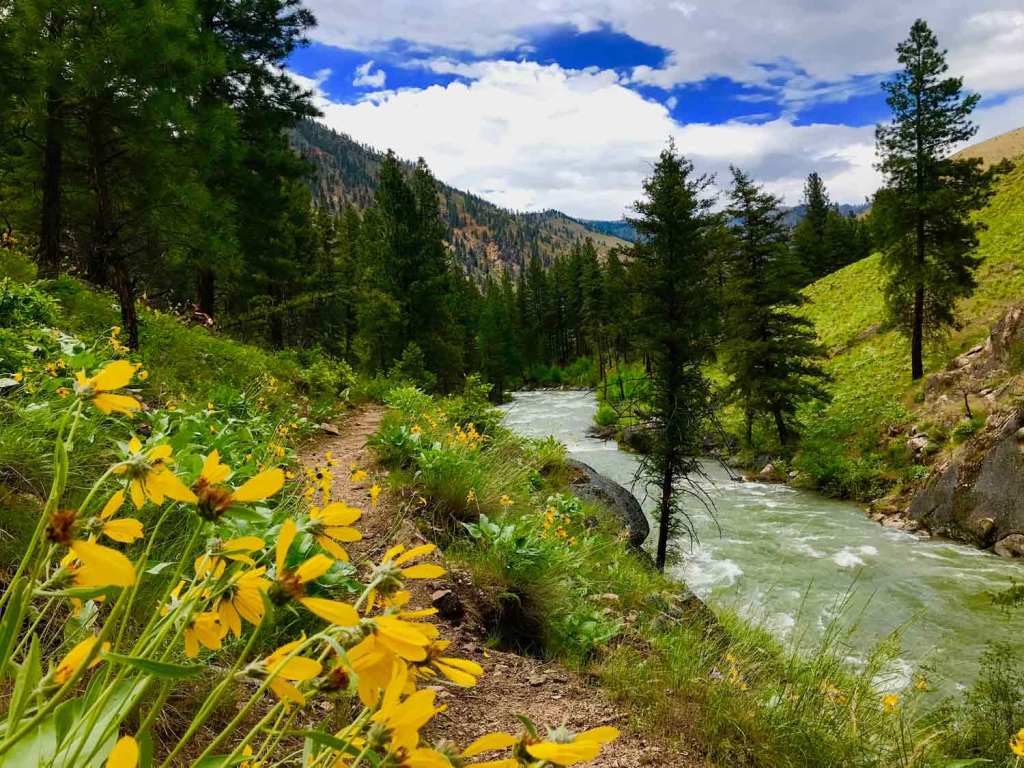The eddy catapults us river left, into a safe zone, and away from the adrenaline-pumping drop. Parallel to our raft, the sweep boat—a 27-foot-long inflatable cargo vessel—isn’t as lucky. The hulk rises several feet above the water with two far-reaching sweep oars at its bow and stern. I watch our friends ping-pong around the deck as the boat nose-dives over Velvet Falls into a colossal hole of swirling whitewater. Sweep guide, Sanne Hilbrich, and Barb Gonzalez, another boater in our group, both fly overboard into the frigid water. A split-second later, Terry Palmer—the only rafter who manages to not fall in—grabs Sanne’s personal flotation device and pulls her out of the rapid’s gut. Barb bobs to the surface and, as the current carries her away, we furiously paddle downstream to catch her.
It’s the third week of May, and we’re five miles into rafting one of the most pristine and wild stretches of the American West: the Middle Fork of the Salmon River. North of central Idaho’s Sawtooth Range, Marsh Creek becomes the headwaters of this remote river, which is fed by another dozen tributaries before Boundary Creek—our launch site. For 104 miles, the Middle Fork flows north, from high alpine forest at about 6,000 feet to the confluence with the Salmon River (colloquially known as the Main Salmon), at half its start elevation. The final segment of the Middle Fork carves through the Impassable Canyon: the third-deepest gorge in North America. The Impassable is deeper than the eminent Grand Canyon, according to the U.S. Department of Agriculture (USDA), and triumphed only by a passage carved by Idaho’s Salmon River and Hells Canyon, which towers above the Snake River. Even before we reach the chasm, the Middle Fork is exceptionally remote. The Middle Fork is one of the nation’s first-ever Wild and Scenic Rivers—a federal protection for waterways that was introduced 50 years ago—and it cuts through the heart of the Frank Church–River of No Return Wilderness: a 2.4-million-acre territory that overlaps with six national forests and is the largest contiguous wilderness area in the lower 48.
Our trip is destined to be fast and rowdy. It’s early spring and consequently, the water’s running high, at a depth greater than six feet and a flow that’s more than 7,800 cubic feet per second, which surges up the canyon walls, accentuates hair-raising plunges and whips against edgy boulders. Much higher, and the water would be impassable, even for skilled boaters. The sheer volume creates shooting speed: We’ll complete the Middle Fork in four days, rather than the six- to eight-day average that’s typical during the summer season and at lower flows.
Matt Leidecker, author of The Middle Fork of the Salmon River: A Comprehensive Guide, writes, “At high water, the first twelve miles is a Class IV+ river with Class V consequences. Infrequent eddies and icy water can turn a flip at Velvet Falls into a very serious situation … this level requires preparation and a strong team.”

The bright-green hillsides that surround the Middle Fork of the Salmon carry an effervescent glow from spring showers in the third week of May. (Photo Credit: Morgan Tilton)
Before we reach her, Barb is intercepted by one of the safety kayakers. Our head guide, Jake Miczulski, acts quickly and calmly. He gives everyone directions, pulls Barb into the boat and we anchor the raft at the river’s edge. “This ludicrous hat—I’m never wearing it again!” Barb exclaims and yanks back her full-brim cap, which was suctioned beneath her helmet and became glued over her eyes. I’m thankful that this is the circumstance, and nothing worse, that needs consolation.
Traveling on whitewater is full of unpredictability. A guide’s ability to efficiently manage risk and emergency response comes with experience. I’m a novice paddler, but fortunately I’m en route with one of the most qualified outfitters on the Middle Fork: Far and Away Adventures, a Ketchum, Idaho-based, 40-year-old, family-run rafting company. Jake, like all of our guides, is in his mid-twenties and is a fierce advocate for the environmental and spiritual benefits of the Middle Fork. As a seasoned local, he grew up paddling with his family, has guided for close to a decade and continues to sharpen his skills via courses, like swift water rescue, that Far and Away arranges for its staff.
Far and Away Founder Steve Lentz understands the nature of the job. His great aunt and uncle were among the first-ever commercial passengers to venture down the region’s Salmon River, in 1946. Steve has run the Middle Fork more than 100 times since his first trip in the ’70s. He even recalls the ecological impact the Wild and Scenic Rivers Act had following the designation in 1968. The grazing of cows and sheep had been disrupting the surrounding riparian habitat. With the passage of the act, the animals were removed, and the water took a big turn in clarity. The protection of the Middle Fork helped make the river a whitewater destination. “To have one of the most pristine, runnable rivers and environments in the world is an incredible asset,” Steve said.
The river’s transparency, ergo good health, is unmistakable. On day one, before we boarded our rafts on the Middle Fork, I saw the crystal-clear water from my passenger window. From the bus, shuttling along Ponderosa Pine Scenic Byway, I watched Marsh Creek’s vibrant kaleidoscope of pebbles and flowing, slender grass fly by. As Steve drove, I chatted with Annie Lentz, Far and Away co-owner and Steve’s wife. She described the economic impact that travelers to the Middle Fork have on the local towns, known as feeder communities. Three decades ago, small municipalities like Stanley, Idaho (population 100), received mail only once a week. Now, retail shops like Riverwear—a freshly renovated store where I stopped to buy neoprene gloves on our way to the put-in—thrive in places like Stanley and Salmon. One-third of the economy in Custer County, where Stanley is located, is attributed to tourism and travel spending: that’s double the rate of tourism in the rest of Idaho, per a 2016 report by University of Montana Research Specialist and Economist Chris Neher.

Led by Far and Away Adventures, the crew pushed off from Boundary Creek put-in. While the sunshine was blissful, the river was immediately turbulent and tough to paddle. (Photo Credit: Morgan Tilton)
“When 10,000 commercial and private floaters go down the Middle Fork in a three-month period—and each paddler spends $300 to $1,000 on a trip—it’s a huge impact for small economies,” says Neher. He reports that 27 outfitters operate on the Middle Fork and the annual revenue that’s collected from those client fees is close to $8.4 million. Beyond rafters and kayakers, the Middle Fork attracts hunters, hikers, horsepackers, backpackers, backcountry skiers and anglers. This 104-mile stretch is one of the few places in the Columbia River Basin that’s home to wild salmon. Gray wolves, reintroduced two decades ago, also live here among the wolverine, lynx, mountain lion, black bear, elk, mule deer, moose, mountain goat and other creatures. The Frank Church – River of No Return Wilderness manages 296 trails, a total of 2,616 miles—yet, far more acreage has zero trails at all. All considering, Neher estimates that the total annual economic impact of Middle Fork-related spending is as high as $15 million in Custer and Lemhi Counties alone. By my third day on the water, I understand why.
At mile 74, we tie off our boats to set up camp before dusk. I stroll upriver. At an inviting bend, I sit with my legs crossed beneath a grove of ponderosa pine and close my eyes to meditate next to the rushing water. The day’s memories flood my mind: a wide-eyed instant of excitement during our day hike, when we’d run into a large family of bighorn sheep on the summit of Johnson Point; being greeted by white-tailed deer here at Survey Camp, our home for the night; learning from our guides about the spiritual presence of the Tukudeka (also known as the Mountain Sheepeater) people. Behind me, several natural depressions are distinguishable, barely, in the raised benchland, and are believed to be their remaining historic house pits. According to the Idaho Museum of Natural History, the isolated tribe occupied the canyon as early as 8,000 years ago. My thoughts settle and I lose track of time. When I finally open my eyes, a bald eagle flies directly toward me, in slow motion above the water. It’s a moment I’ve never experienced despite a lifetime in the Rockies.
The Middle Fork is a diamond in the rough, both here in the U.S. and worldwide. As we devour a delicious beachside lunch beneath the sun on day two, the guides joke about how they missed Far and Away’s gourmet menu when they were paddling in Ethiopia, less than two months earlier. Sanne, Jake and four other Far and Away guides embarked on a 35-day trip, via rafts and kayaks, to complete the last descent of the Blue Nile in Ethiopia. In navigating more than 500 miles, they passed threatening crocodiles and hippos, exchanged greetings with subsistence farmers and ultimately, were among the final boaters to experience portions of the Blue Nile’s Grand Canyon before one of the largest hydroelectric dams in the world is completed. The development will have a tremendous impact on the people who live along and depend on the river, reports National Geographic. Conservationists are concerned the enterprise will displace close to 5,000 villagers who inhabit a 200-kilometer stretch of the river, according to Power Technology. Yet, the dam, called the Grand Ethiopian Renaissance Dam Project, is estimated to provide 6,000 megawatts of electricity, or, 15,000 gigawatt hours of power per year, states Italy-based primary contractor, Salini Impregilo. The double-edged sword is that the dam will introduce energy that may improve quality of life in rural communities by allowing people to light their homes and cut down on health issues caused by household air pollution.

After leaving Lower Grouse, the gorge’s character morphs into a rougher and more rugged environment. Far and Away Adventures Raft Guide Galen Barker steers the sweep boat, which carries the team’s camp gear. (Photo Credit: Morgan Tilton)
I feel ignorantly unaware of the overseas issue and curious about Ethiopian culture, so I continue to ask my guides about their experience. During the passing miles, as we float, share meals and explore sights on land, Sanne and I chat about her affinity for river habitats and fish, and how her extraordinary experience of drifting in Africa may have widened her perspective. Sanne graduated from Montana State University in May 2017 with an environmental science degree. She penned her senior thesis on the Snake River’s salmon and steelhead populations, and the potential positive impact that removing four dams on the Lower Snake River could have on those fish. Now, she’s applying to graduate school to get her master’s in environmental education and pursue a teaching career along with river guiding. She’s torn by the dam construction in Ethiopia:
“The reservoir will flood hundreds of tribal communities that have no idea it’s even happening. Ethiopia is full of ancient culture, and if that culture gets wiped out, the history of those people will disappear,” Sanne says. On the other hand, she adds, “I do see the positive side of this dam in Africa on the Blue Nile with the benefits of electricity.” We pause. She and I sit on a fallen tree, listening to nature’s orchestra of creaking woods, trilling birds and the flying Middle Fork, and it is not lost on us that we are extremely fortunate to be here. This river will remain relatively unchanged. Sanne describes the contrast: “On the Blue Nile, there are no regulations. Everything goes into the water: It’s where you shower, drink and dispose of waste. It’s not that way here in the U.S., because of the Wild and Scenic Rivers Act.”
In the U.S., the Wild and Scenic Rivers Act was established in response to the water resource development projects, dams and diversions that occurred nationwide from the 1930s to the 1960s. The intent of the enactment is for rivers to be preserved and protected in a free-flowing condition for today’s recreationists and future generations, states the USDA. Despite the Middle Fork’s secure status, today, only 209 rivers are guarded by the act. The potential is much grander: 3.6million miles of streams exist and at least 3,200 rivers qualify as Wild and Scenic, according to Denielle Perry, assistant professor in the School of Earth Sciences and Environmental Sustainability at Northern Arizona University.
Our nation’s slow forward-motion for protecting waterways is further strained pressure from extractive industries and pitches for fresh construction. A year ago, the Department of the Interior released a federal review of 27 national monuments in response to President Trump’s executive order. And recent dam proposals—like California’s Centennial Dam or structures on Colorado’s Maroon and Castle Creeks—continue to surface, which concern local residents and river advocates due to impacts like the flooding of cultural sites and choked streamflow for fish downstream.

The view from the Loon Creek Trail, which runs along loud gray-emerald waters and leads to the trail’s namesake riverside hot springs. The Frank Church – River of No Return Wilderness is filled with these hidden gems. (Photo Credit: Morgan Tilton)
Knowing passionate river guides like the Far and Away crew, who are teachers and stewards of our country’s natural and human resources, gives me hope for a future that responsibly holds and expands our public water and land. Jake, Sanne and their colleagues devote their lives to studying Idaho’s unique geology, ecology, wildlife and human history with an intent to share that knowledge through hands-on engagement. On our final day on the water, my knuckles go white as I grip the sweep boat’s railing next to my swivel seat, and I remind myself to trust our teamwork and their leadership.
For 25 miles, my eyes become fixated. After Big Creek, a tributary near mile 78, the Impassable Canyon begins. Until this point, the peripheral alpine-peppered, high-desert slopes and jagged ridgelines towered 3,000 feet over the Middle Fork. But here, the canyon becomes narrow and remarkably consolidated. Abrupt, concrete-like walls spike 5,000 feet above us, and I gaze upward to observe the dark-toned, V-shaped batholith and its alabaster-colored waterfalls. Layers of the beveled mountainsides mimic sinking battleships. Shrubs and Douglas-firs cling to the vertical terrain despite the impossible steepness. Holes between the tight rapids, which have surged in size and frequency due to the rock-solid ravine, nearly swallow our sweep boat.
After we jostle through Redside Rapid, near mile 80, our boat is throttled through a series of hydraulic waves—known as Weber Rapid—before a stretch of calm. I take my mind off the flow and ask Jake what his plans are for August, when he finishes up the guiding season. He says he’s starting a graduate program at the University of Idaho McCall Outdoor Science School. His master’s will be in natural resources with an emphasis in environmental education and science communication. His ultimate plan? To introduce as many youths as possible to radical experiences in the outdoors, and to continue to share the Middle Fork’s magic for generations to come.


